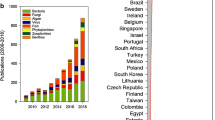Abstract
Biological monitoring requires identification of the fauna of the environment under study. Three prevalent methods have been used to alleviate the need for universal species-level identification: selection of indicator taxa, taxonomic reduction, and allocation to functional groups. Each method is discussed in relation to species recognition. It is suggested that the validity of all attempts to reduce data should be tested in the light of phylogenetic hypotheses.
Similar content being viewed by others
References
Faith, D. P.: 1989 ‘Benthic Macroinvertebrates in Biological Surveillance: Monte Carlo Significance Tests in Functional Groups Responses to Environmental Gradients’,J. Env. Monit. Ass. 14. 249–266.
Furse, M. T., Moss, D., Wright, J. F., and Armitage, P. D.: 1984, ‘The Influence of Seasonal and Taxonomic Factors on the Ordination and Classification of Running-Water Sites in Great Britain and on the Prediction of Their Macro-Invertebrate Communities’,Freshwat. Biol. 14, 257–280.
Greenslade, P. and Greenslade, P. J. M.: 1984, ‘Invertebrates and Environmental Assessment’,Envir. Plan. 3, 13–15.
Greenslade, P. and Greenslade, P. J. M.: 1987, ‘Ecological Strategies In Collembola: A New Approach to the Use of Terrestrial Invertebrates in Environmental Assessment’, in B.R. Striganova (ed.),Soil Fauna and Soil Fertility, Proceedings of the 9th International Colloquium on Soil Zoology, ‘Nauka’, Moscow, pp. 245–252.
Hellawell, J. M.: 1977, ‘Change in Natural and Managed Ecosystems: Detection, Measurement and Assessment’,Proc. R. Soc. London. B. Biol. Sci. 197, 31–57.
Hildrew, A. G., Townsend, C. R., and Hasham, A.: 1985, ‘The Predatory Chironomidae of an Iron-Rich Stream: Feeding Ecology and Food Web Structure’,Ecol. Ent. 10, 403–413.
Merritt, R. W. and Cummins, K. W.: 1978,An Introduction to the Aquatic Insects of North America, Kendall/Hunt Publishing Company, Dubuque, Iowa 52001.
Moran, V. C. and Southwood, T. R. E.: 1982, ‘The Guild Composition of Arthropod Communities in Trees’,J. Anim. Ecol. 51, 289–306.
Morris, D. L. and Brooker, M. P.: 1982, ‘An Assessment of the Importance of the Chironomidae (Diptera) in Biological Surveillance’, in D. A. Murray (ed.),Chironomidae. Ecology, Systematics, Cytology and Physiology. 354 pp. Pergamon Press, Oxford, New York, Toronto, Sydney, Paris, Frankfurt, pp. 195–202.
Mound, L. A.: 1983, ‘For a Taxonomist You Seem to Know a Lot About Biology’.Antenna 7, 3–5.
National Environment Research Council: 1976,Report on the Role of Taxonomy in Ecological Research, Publication series B, No. 14. N.E.R.C. in London. iv+48 pp.
Nelson, G. and Platnick, N.: 1981,Systematics and Biogeography. Cladistics and Vicariance. Columbia University Press, New York.
Resh, V. H. and Unzicker, J. D.: 1975, ‘Water Quality Monitoring and Aquatic Organisms: The Importance of Species Identification’,J. Wat. Poll. Cont. Fed. 47, 9–18.
Rosenberg, D. M., Danks, H. V., and Lehmkuhl, D. M.: 1986, ‘Importance of Insects in Environmental Impact Assessment’,Envir. Man. 10, 773–783.
Saether, O. A.: 1979, ‘Chironomid Communities as Water Quality Indicators’,Hol. Ecol. 2, 65–74.
Vannotte, R. L., Minshall, G. W., Cummins, K. W., Sedell, J. R., and Cushing, C. E.: 1980, ‘The River Continuum Concept’,Can. J. Fish. Aquat. Sci. 37, 130–137.
Warwick, R. M.: 1988a, ‘Analysis of Community Attributes of the Macrobenthos of Frierfjord/Langesundfjord at Taxonomic Levels Higher Than Species’,Mar. Ecol. Prog. Ser. 46, 167–170.
Warwick, R. M.: 1988b, ‘The Level of Taxonomic Discrimination Required to Detect Pollution Effects on Marine Benthic Communities’,Mar. Poll. Bull. 19, 259–268.
Waterhouse, J. C. and Farrel, M. P.: 1985, ‘Identifying Pollution Related Changes in Chironomid Communities as a Function of Taxonomic Rank’,Can. J. Fish. Aquat. Sci. 42, 406–413.
Winterbourne, M. J., Rounick, J. S., and Cowie, B.: 1981, ‘Are New Zealand stream ecosystems really different’,New Zealand J. Mar. Freshw. Res. 15, 321–328.
Wright, J. F., Moss, D., Armitage, P. D., and Furse, M. T.: 1984, ‘A Preliminary Classification of Running Water Sites in Great Britain Based on Macro-Invertebrate Species and the Prediction of Community Type Using Environmental Data’,Freshw. Biol. 14, 221–256.
Author information
Authors and Affiliations
Rights and permissions
About this article
Cite this article
Cranston, P.S. Biomonitoring and invertebrate taxonomy. Environ Monit Assess 14, 265–273 (1990). https://doi.org/10.1007/BF00677921
Issue Date:
DOI: https://doi.org/10.1007/BF00677921




